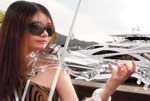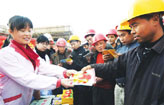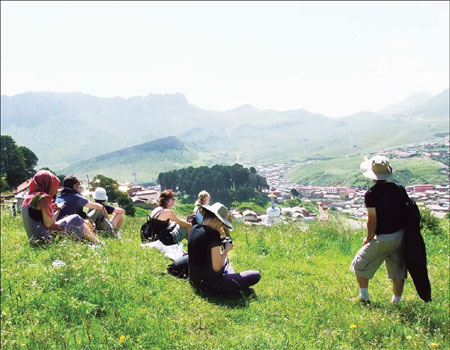Tips and Articles
Taking the high road
Updated: 2011-04-10 07:56
By Mike Peters (China Daily)
Mike Peters waxes lyrical about the pleasures of Lanzhou and southern Gansu as he stops to smell the flowers and discover a little piece of Switzerland in China.
|
Southern Gansu province offers historic Tibetan Buddhist monasteries, grand mountain vistas and a real escape from the urban rat race. Mike Peters / China Daily |
Eight of us are trudging up a mountain ridge into thinning air. Soft, green grass shrouds the steep but graceful slopes that surround us. Near the end of a hike in a vertical field of wildflowers, the purple and yellow blossoms become dotted with familiar white star-shapes. At about 3,000 meters above sea level, our steps come more slowly but we are not hallucinating.
Or are we? Those white flowers - could they be edelweiss?
They are, and we stop to catch our breath and gawk at Switzerland's national flower like a bunch of giddy Von Trapps. We are not in Europe's Alps but in the hills above the Labrang monastery in Xiahe. Here, the sound of music comes from Buddhist monks chanting Tibetan prayers.
Most of the expatriates on this trip, organized by the China Culture Center, are here for two reasons. First, to get out of Beijing or Shanghai and see a more rural face of China. Second, to experience a slice of Tibetan culture, without taking the time to go all the way to Lhasa.
 |
"It's a wonderful place where you can also see the life and folkways of the Hui and Tibetan," says CCC's director of operations, Alex Gu. "The area is the birthplace of Tibetan Buddhism, so it's a pure example of that tradition and religious culture."
Our tour started in Lanzhou, the provincial capital, which offers tourists plenty to see on arrival. The Yellow River originates in the region, and a stroll along the river takes us to the Qin Opera museum, a drama school older than Peking Opera. Some of us grab the chance to cross the river on a raft made in ancient style. The rustic boats are stick frames mounted on tanned, inflated sheepskins for flotation. Until about a century ago, this was typical river transportation, including commercial barges that each took about 600 sheepskins to keep them buoyant at this Silk Road hub.
We board a tour van for the five-hour drive to Xiahe. As the minibus climbs steadily, we are glued to the vista of mountains gleaming under the setting sun, the slopes terraced in a style the locals learned from farmers in Yunnan province. Bright patches of green and yellow signal that rapeseed and other crops are nearly ready to harvest.
The next morning we rise early, exploring the narrow streets and alleyways of Xiahe below the great monastery of Labrang. Crimson-robed monks rush from household chores to prayer as we walked along the kora, a 3-kilometer "pilgrim path" that winds around the monastery. Along the path are long rows of prayer wheels, with intricate calligraphy capturing prayers on gleaming cast brass or colorfully painted wood. Monks, villagers and tourists who aren't shy give the drumlike wheels a spin as they pass, figuratively sending the sacred words into the air and the surrounding world. About half of the tourists are Westerners, but about as many are pilgrims from Lhasa and nearby provinces with a lot of ethnic Tibetans.
Friendly monks grin tolerantly at cameras in the public areas outside the monastery buildings - recently tourism has become an important source of income for the community. Most monks are a little more worldly than Westerners might imagine from the movies.
"It's common to see young monks surfing online at the Internet cafes in town," says local guide Dennis Qin. "Some of the teenagers even play video games, shooting each other with guns. Some monks own private cars - they are not kept from the world."
Older monks are more traditional, especially down the road at our second monastery destination: Langmu. This rural Tibetan village of 3,000 is tucked amid steep green meadows, thick evergreen forests and mountains that stay snow-capped for most of the year.
Langmu means "fairy," and the town got its name from a rock inside a nearby cave which resembles a beautiful young woman. Quiet and picturesque, Langmusi attracts backpackers - and a few white-collared folks - who are eager to trade their city lives for a brief few days in a place that has only one street.
Flying from Beijing to Lanzhou and back has made the whole trip possible in four days. Once the capital disappeared in the rear-view mirror, life seemed to shift into low gear, from the monasteries to the markets and finally to the nomad camp we visited on the high grasslands.
After an afternoon of horseback riding and leisurely hiking in the freshest air we could remember, it was time to leave and the van's battery was dead. While locals slid under the vehicle and happily banged away with hammers, we tourists grabbed a few more beers and roamed back to our picnic spot under a stunning blue sky. We were almost sorry when the engine roared to life about 90 minutes later. There are worse places to be stranded.
E-paper

Han me downs
Traditional 3,000-year-old clothes are making a comeback.
Reaching out
Fast growth fuels rise in super rich
Chinese tourists spend more
Specials

Big spenders
More mainland tourists are expected to spend money on overseas travel this year.

Rise in super rich
Report cites rising property prices, gdp as key drivers of increasing number of chinese millionaires.

Reaching out
Condom makers are stepping up their presence in smaller cities to boost sales

